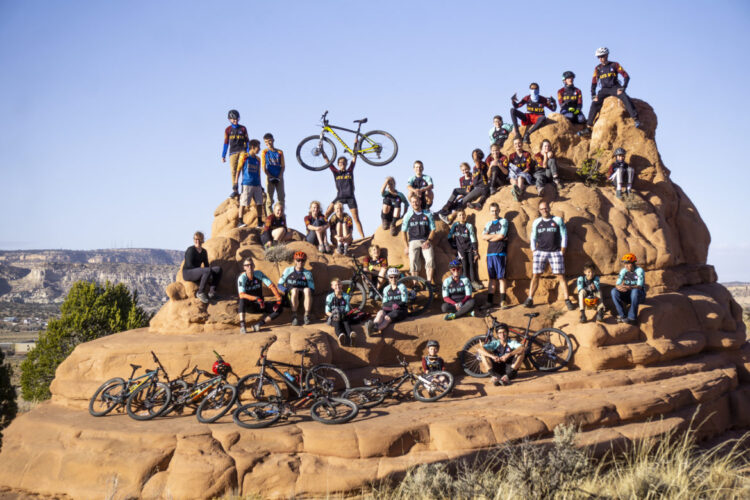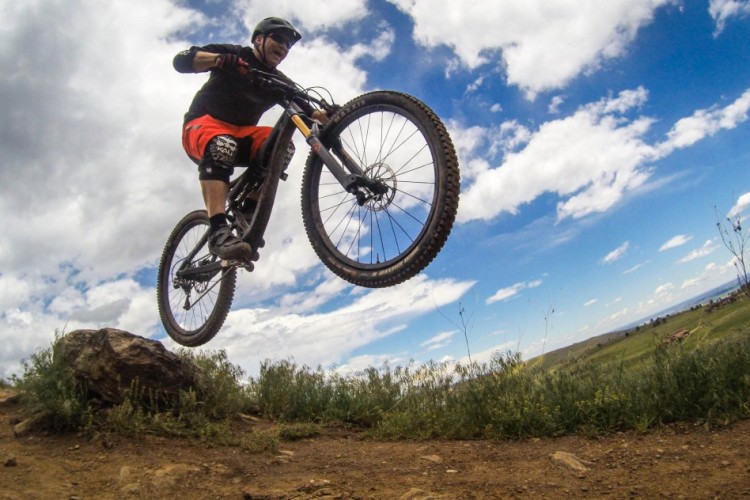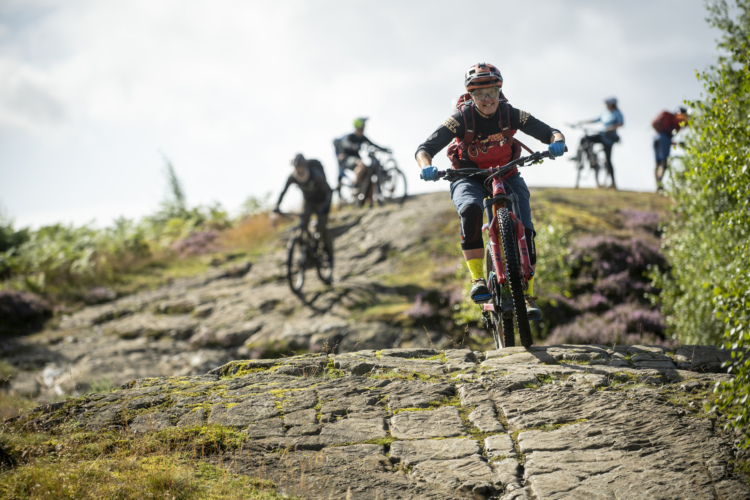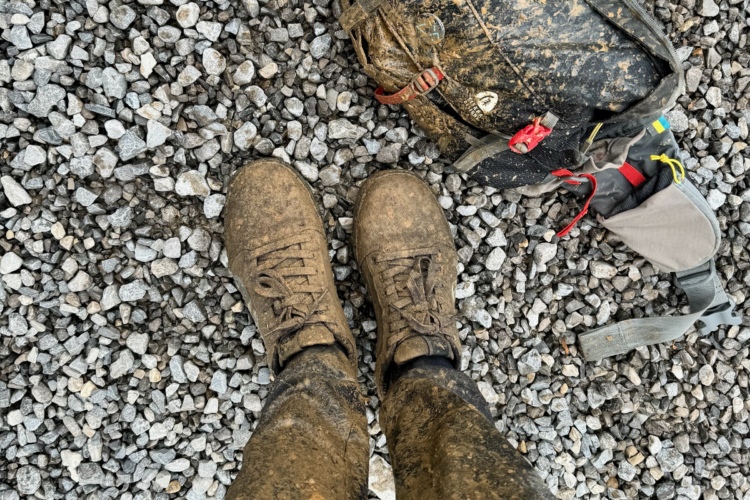Having covered the administrative details of NICA racing in part one, I will now give a quick blurb on each of the races and share what I think were the most intriguing observations of our season of fast dirt.

Race 1: YMCA of the Rockies Granby Ranch, Granby, CO
We were quite excited as we entered the last few training rides leading up to the first race. The Colorado NICA site even posted link to a helmet cam video of the course: it looked to be as much doubletrack as singletrack and not at all technical, which was a disappointment, but still, all that training was finally going to give way to an actual race. Then, a few days before the race, doing something that had nothing to do with cycling, miniskibum gave himself a major concussion. Suddenly, he was out of the race and we were out our registration fee and the nonrefundable portion of our hotel bill.
The report from the race was that, despite the easy-looking course, the day was not without its difficulties. One portion of the course ran close to the edge of a lake and a few riders ended up taking an involuntary bath. Heavy rains arrived early in the afternoon and forced a shortening of the later races, including the boys varsity event. Between the less interesting course and the weather difficulties, if we had to miss a race, this would be the one to miss.

Race 2: Colorado Mountain College, Leadville, CO
After getting cleared by the doc, Miniskibum resumed training and had a full two weeks to prepare for Leadville. Of course, one can’t truly prepare for Leadville, as the course starts at over 10,200 feet and goes up from there. We went up the afternoon before the race, enjoyed a very pleasant pre-ride, followed by a team dinner at the vacation home of one of our racers, and then got some killer 10,000ft sleep.
The next morning, however, we woke to very cold temps and a steady, pounding rain. I feared the race might not go on. But go on it did, and the first wave, freshman girls, had a tough go of it on their first lap, but then the sun busted out and they had a much more pleasant second lap. By the time Miniskibum was up, course conditions were near-perfect and most riders enjoyed a perfect race over a largely entertaining course. But then again, afternoon rains rolled in and made an absolute mess of the boys varsity race.

One other really nice thing happened here: they applied our fee from the previously missed race to cover this race. They didn’t have to, so that was a pleasant suprise
Race 3, Peaceful Valley Scout Ranch, Elbert, CO
This being the closest thing to a “local” race for us, I volunteered for a couple positions. First, I spent Saturday morning doing course setup and marking so that it would be available for pre-ride by Saturday afternoon in anticipation of Sunday’s race. The NICA video on course marking was very helpful, and I felt well-trained as I drove to the venue. Combine that with an experienced volunteer at my side for my first marking experience, and it was a snap. For Sunday’s races, I volunteered to assist with staging the first three waves, and was free by the time Miniskibum took off. I highly recommend the volunteer experience, even if you don’t have kids in the race.

Despite being well east of Colorado Springs, this venue sat on the edge of Black Forest, so it looked more like a typical Colorado ponderosa forest than like the prairie that surrounds it. This course even had a couple of the most technical spots of all four venues, and it made for a near-perfect race course, alternating between wide-open, pure aerobic sections and narrow, twisty singletrack where technical skills were at a premium. Riders got a good variety and they were never far from an opportunity to pass. One sharp, loose turn at the bottom of the hill closing the loop did take out a few riders who charged it too fast or lacked cornering skills.

Race 4: State Championship at the Haymeadow Trail, Eagle, CO
The town of Eagle has worked hard to develop and display its mountain biking credentials, and has done exceptionally well overall. The town expended funds and locals performed labor for the creation of this loop, designed and built specifically for the state championship race—while also being open to recreational riders the other 364 days of the year. During the pre-ride, I couldn’t help but notice this was by far the funnest loop of the four with plenty of sketchy, techy bits and a series of bermed switchbacks near the end of the loop. However, I also noticed that, once past the initial grass meadow and into the mountainous pinion forest, opportunities to pass were few and far between. This was borne out in the race, as most strong technical riders were frustrated at getting caught behind less skilled but aerobically strong riders who leapt out in front at the start, but then slowed down and created bottlenecks in the more technical areas. Some of those techy bits proved to be a bit too much for a number of riders as there were a series of crashes, including one that took out a rider even on the pre-ride.

My 5 most intriguing observations from the season:
1. There is a huge variation in the aerobic capabilities of the riders, even within each division. There are a few highly competitive riders, a few who can be counted on to be far back of the pack, and a giant chunk in between. I was surprised at how many kids participate who have no chance of threatening the podium. Kudos to them and kudos to this activity for welcoming all who wish to push themselves, even if they’re not the most gifted.
2. There is a huge variation in the technical capabilities of the riders as well. Some could almost compete in trials competitions, and others are merely crossover roadies who panic at the sight of a small root or rock. Again, though, most are moderately skilled riders for whom the courses are challenging but manageable.
3. Technical and aerobic capabilities seemed to be inversely related. The fittest riders almost always showed some trepidation at the techy bits while the strong technical riders fell well behind the pack on the climbs and wide-open stretches. It was rare to see a rider who excelled in both areas. I suspect that will change as more riders enter mountain biking at a young age. Starting early goes a long way in developing technical skills.
4. There is huge variation in the equipment being used. Walking through the pit area, you’ll see sitting side by side on a team’s rack a brand new $4k, full-carbon, ultralight, 29in race steed and a 30-year-old rigid steel tank that was probably dad’s first mountain bike back in the day. Even miniskibum was relegated to riding a 35lb full-squish 26er, since I had no idea he’d be racing one day and focused on getting him a capable, beefy, all-mountain rig that could handle the abuse of his technical pounding.
5. Despite efforts to throw in techy bits and just some good old-fashioned fun singletrack, the courses still heavily favored the strong aerobic riders. Once in the technical sections, if the technical riders caught up, the trails simply offered no opportunity to pass short of the rider in front pulling off and coming to a complete stop. While I witnessed nothing but exceptional ethics and sportsmanship throughout the season, this is a bit much to ask. Once an opportunity to pass arose, the course would be an extended, purely aerobic section, so the pass would be pointless as the stronger aerobic rider would soon regain his position anyway. This tendency is certainly not unique to high school racing, but did seem to be more prevalent than it should be. It would be nice to see some courses incorporate technical sections that still allow adequate width for passing. High school enduro, anyone?
6. And for the coolest observation of all: the entire experience seemed to strike that ever-so-elusive balance between competitive and supportive. As previously noted, ethical behavior and sportsmanship were far above what I’ve experienced in other sports. As a parent, it was especially cool to enjoy the experience with other parents, even from rival teams, without the animosity that frequently accompanies the likes of high school football, club soccer, or little league baseball.

I look forward to watching NICA and high school mountain bike racing grow, and even continue their expansion into the middle school range. I posit that the wholly chill and supportive atmosphere is largely a product of the intimacy the sport currently enjoys and its volunteer, grass-roots driven foundation. The challenge will be to somehow retain that sense of community as the sport goes “big time” in the coming years.











11 Comments
Nov 6, 2013
Nov 6, 2013
Nov 6, 2013
Nov 6, 2013
I encourage anyone who rides to do a few races, it's a good experience.
Great post!!
Nov 6, 2013
I hadn't thought about it, but you're right--the vibe at these races was not unlike the few races I've done as an adult, but I would say that the positive aspects were even stronger at these NICA races.
I witnessed a few instances where a less skilled technical rider in front would move over to allow a pass, but get a little squirrely in the rocks and lose the line, cutting off the more skilled rider behind. Every time, the rider would apologize -- and the rider behind would respond with a friendly "no worries" (and he meant it--zero animosity in the voice despite what must be a somewhat frustrating position) and then pass when the opportunity returned. It was really quite amazing.
Nov 6, 2013
Nov 6, 2013
Nov 6, 2013
Nov 6, 2013
http://www.ourcoloradonews.com/highlandsranch/life/rocky-heights-riding-high/article_c55501e0-3034-11e3-80d9-0019bb2963f4.html
Nov 6, 2013
http://www.bicycleretailer.com/north-america/2013/08/21/nica-test-middle-school-program#.UnpAeHWJDH8
I already emailed NICA to see when this is coming to CO!
Nov 6, 2013